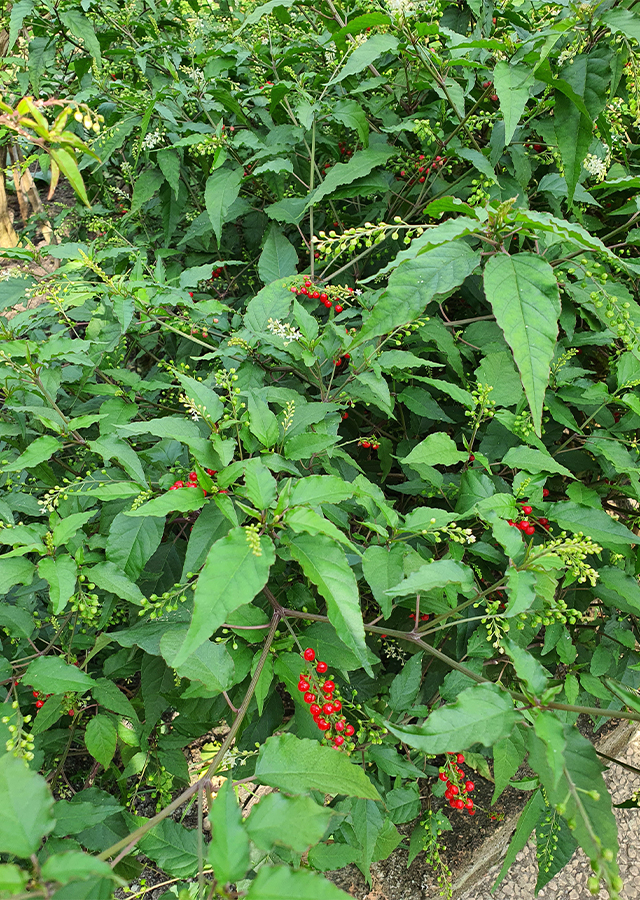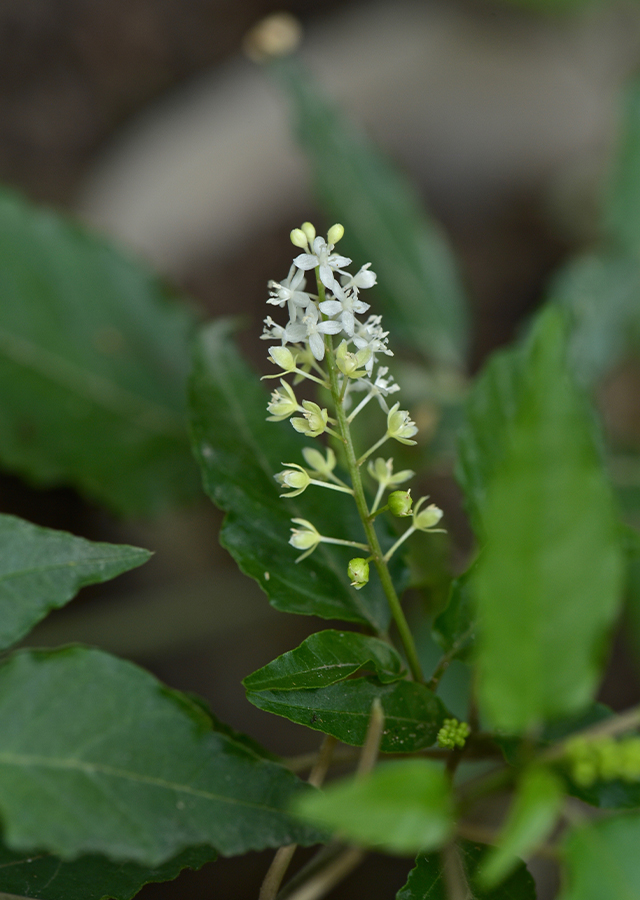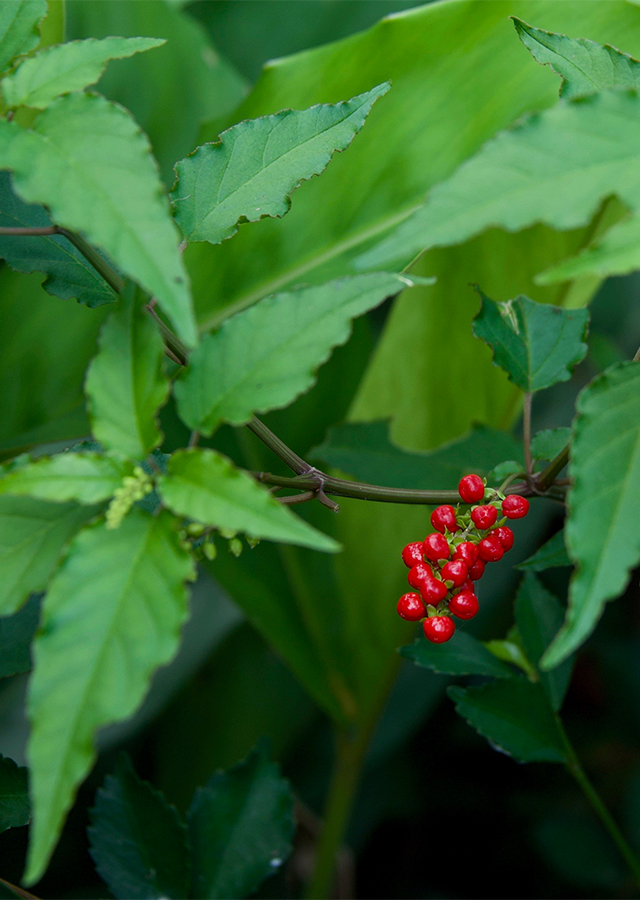Bloodberry
Rivina humilis L.
Petiveriaceae
Location in our garden
Principal



Synonym
Rivina acuminata Raf.
Rivina aurantica Warsz. ex Schenk
Rivina bengalensis S.C.Srivast. & T.K.Paul
Habitus
Herbaceous. Bloodberry is an erect, vine-like herbaceous perennial plant, growing up to about 1 m high, flowering plant.
Part Used
Leaves
Fruit
Growing Requirements
Full Sunshine
Need Shade
Habitat
Riverbanks
Forest
Roadside
Shrublands
Grassland
Overview
Bloodberry is a small, upright, or straggling perennial herb, native to the southern US, Mexico, the Caribbean islands, and Central and South America. The plant is now pantropical and often considered a pest plant outside the Americas. Although the berries are considered toxic to humans, birds find them irresistible. The plant is recommended to attract birds to the garden.
Vernacular Names
Coralito (Spanish), Sminkbär (Swedish), Bloedbessie (Africa), Rougeplant (English), pigeonberry (USA), Groseile (French), Coralberry (Australia), Shu zhu shan hu (Chinese).
Agroecology
R. humilis is a plant of the wet tropics, found in forests, thickets, on roadsides, and disturbed areas at elevations from sea level to 1,700 m. It is weedy plant of waste areas, urban bushland, and often in shady places. it can tolerant of a range of soil types and of salt spray and saline soils, also can frost-tolerant down to -18 C.
Morphology
- Stem - grooved, solid, and softly pubescence when young. younger stems are greenish in color and mostly hairless.
- Leaves - are simple, alternate, entire with a wavy margin. The blade is light green, thin textured, ovate to ovate-elliptic, supported by a long slender petiole, 10-50 mm long . The base is round and the apex is acuminate. The upper leaf surface is glabrous and the lower surface is covered with a few minute hairs along the midrib and main veins.
- Flowers - are 2-3 mm in diameter, shortly pedicellate (2-3 mm). The 4 petals are obovate, turn from white or pinkish to greenish as they mature; four white stamens.
- Fruits - are glossy, small, bright red berries, subglobose (4 mm in diameter) with one seed per fruit, turn from green to bright glossy red as they mature.
- Seeds - 2.5-3.5 mm in diameter, puberulent.
Cultivation
It is propagated by seeds, stem cuttings and leaf cuttings.
Chemical Constituents
Leaves: phenolic compound, flavonoids, saponins, alkaloids, triterpenoids, steroids, tannins. Fruits: rivianin or rivinianin (IUPAC 5-O-β- D- glucopyranoside), 3-sulfate, betaxanthin humilixanthin.
Traditional Medicinal Uses
Medicinal Uses
- Used for intestinal tonic, treat colds, diarrhea, gonorrhea, ovarian pain, blood purifier, and antioxidant.
- These plants are antiseptic and febrifuge and antibacterial.
- the fruit extract had antibacterial activity against Klebsiella pneumonia and E. coli.
- Used in the treatment of colds, diarrhea, urinary problem, flatulence, gonorrhea, jaundice.
Traditional Uses
- In Sri Lanka, it is used for treatment epilepsy and dysentery.
- The leaves used for catarrh and for treating wounds.
- Reducing ovarian pain and help nourish the womb.
Part Used
Reference Sources
- CABI. (2013). Invasive Species Compendium. Rivina humilis (bloodberry). https://www.cabi.org/isc/datasheet/116742#tosummaryOfInvasiveness.30-03-2021.
- Fern, Ken. (2014). Useful Tropical Plants. Rivina humilis. http://tropical.theferns.info/viewtropical.php?id=Rivina+humilis. 30-03-2021.
- Flowers of India. (No date). Blood Berry. http://www.flowersofindia.net/catalog/slides/Blood%20Berry.html. 20-02-2021.
- GBIF. (2019). Rivina humilis L. https://www.gbif.org/species/101400468 . 20-02-2021.
- Pl@nt Net. (No date). Plantinvasivekruger - Phytolaccaceae - Rivina humilis L. http://publish.plantnet-project.org/project/plantinvasivekruger/collection/collection/synthese/details/RIVHU 20-02-2021.
- Research Gate. (2013). Rivina humilis L: A Potential Antimicrobial and Antioxidant Source. https://www.researchgate.net/publication/287702221_Rivina_humilis_L_A_Potential_Antimicrobial_and_Antioxidant_Source. 20-02-2021.
- Herbpathy. (No date). Rivina humilis herb uses benefits, cures, side effects, nutrients. https://herbpathy.com/Uses-and-Benefits-of-Rivina-Humilis-Cid6128. 20-02-2021.
- Ayurvedic Medicinal Plants of Sri Lanka. (No date). Rivina_humilis. http://www.instituteofayurveda.org/plants/plants_detail.php?i=984&s=Family_name 20-02-2021.
- Bioedukasi Jurnal Biologi dan Pembelajarannya. (2018). The Effect of Extract of Getih-Getihan (Rivina humilis L.) on Armyworm (Spodoptera litura F.) Mortality. https://jurnal.unej.ac.id/index.php/BIOED/search/authors/view?firstName=Dewi&middleName=&lastName=Nurhayati&affiliation=&country=ID. 20-02-2021.

